
El Morro National Monument is a U.S. national monument in Cibola County, New Mexico, United States. Located on an ancient east–west trail in the western part of the state, the monument preserves the remains of a large prehistoric pueblo atop a great sandstone promontory with a pool of water at its base, which subsequently became a landmark where many centuries of explorers and travelers left historic inscriptions that survive today.

Hollin Hills is a neighborhood in Hybla Valley, Virginia, though much of the neighborhood was transferred to the Fort Hunt CDP for census purposes before 2010. It abuts the Villamay and Mason Hill neighborhoods, just south of Alexandria in the South Alexandria section of Fairfax County, Virginia.

Buildings, sites, districts, and objects in Virginia listed on the National Register of Historic Places:
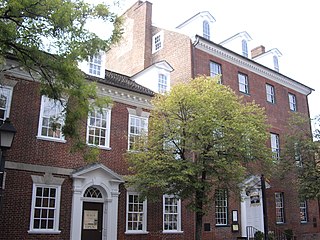
Gadsby's Tavern is a historic commercial building at 138 North Royal Street in Old Town Alexandria, Virginia. Built c. 1785 and enlarged in 1792, the tavern was a central part of the social, economic, political, and educational life of the city of Alexandria, and was designated a National Historic Landmark in 1963. Currently, the building is home to Gadsby's Tavern Restaurant, American Legion Post 24, and Gadsby's Tavern Museum, a cultural history museum. The museum houses exhibits of early American life in Virginia, and the restaurant operates in the original dining room, serving a mixture of period and modern foods.
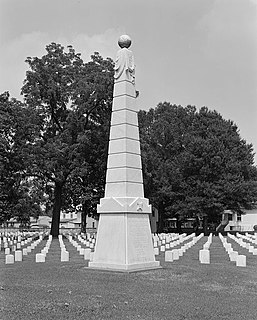
City Point National Cemetery is a United States National Cemetery in the community of City Point within the city of Hopewell, Virginia. Administered by the United States Department of Veterans Affairs, it encompasses 6.7 acres (2.7 ha), and as of the end of 2005, had 6,909 interments. It is managed by Hampton National Cemetery.

Union Square is a neighborhood located in the Sowebo area of Baltimore. It dates to the 1830s and includes a historic district of houses and commerce buildings.
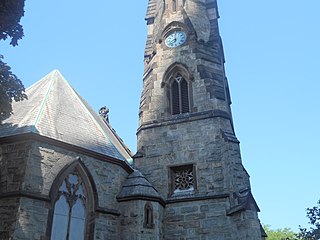
Trinity-St. Paul's Episcopal Church in New Rochelle in Westchester County, New York was added to the National Register of Historic Places in 2006. It is located at the northwest corner of Huguenot Street and Division Street. This church represents the body of the majority group of New Rochelle's founding Huguenot French Calvinistic congregation that conformed to the liturgy of the established Church of England in June 1709. King George III gave Trinity its first charter in 1762. After the American Revolutionary War, Trinity became a parish of the Protestant Episcopal Church of America.

Augustus Lutheran Church is a historic church and Lutheran congregation at 717 West Main Street in Trappe, Pennsylvania. Consecrated in 1745, it is the oldest Lutheran church building in the United States. It continues to be used by the founding congregation for services during the summer. It was designated a National Historic Landmark in 1967.

The Denton County Courthouse-on-the-Square is the former courthouse of Denton County located in the county seat Denton, Texas. The Denton County Courthouse-on-the-Square was constructed in 1896. In addition to county offices, the "Courthouse-on-the-Square Museum" also calls it home. The courthouse is listed on the National Register of Historic Places.

The Reynolds Homestead, also known as Rock Spring Plantation, is a historic plantation on Homestead Lane in Critz, Virginia. First developed in 1814 by Abraham Reynolds, it was the primary home of R. J. Reynolds (1850-1918), founder of the R. J. Reynolds Tobacco Company, and the first major marketer of the cigarette. It was designated a National Historic Landmark in 1977. The homestead is currently an outreach facility of Virginia Tech, serving as a regional cultural center. The house is open for tours.

Greenlawn Memorial Park, also known as Greenlawn Cemetery, is located at 2700 Parish Avenue, Newport News, Virginia. Greenlawn Memorial Park is a 50-acre (200,000 m2) cemetery located where two natural streams, Mill Dam Creek and Salters Creek, come together. The cemetery has been in continuous operation, serving the Newport News and Hampton, Virginia, since 1888. There are approximately 20,000 burials in the cemetery. Greenlawn Memorial Park is on the National Register of Historical Places.

Shannon Cemetery is a historic cemetery located near Pearisburg, Giles County, Virginia. It consists of two discontiguous sections, a white section and a black section, located approximately a thousand feet apart at about 1,900 feet in elevation above sea level. The white (south) section was established in 1781 and contains a variety of grave markers including inscribed and uninscribed fieldstones, decoratively carved tombstones of indigenous stone and imported marble, concrete markers, and twentieth century granite monuments. The black (north) section was established in the 19th century and has small uninscribed fieldstone markers and one professionally carved marble headstone. The Shannon Cemetery is believed to be the oldest maintained cemetery in the county.
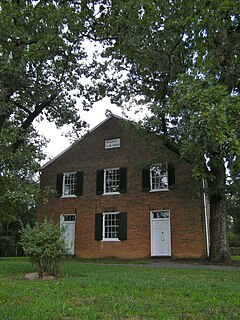
Mount Zion Old School Baptist Church, also known as Mount Zion Primitive Baptist Church and Mount Zion Old School Predestinarian Baptist Church, is a historic Primitive Baptist church located at Gilberts Corner, Loudoun County, Virginia. It is now maintained by the Northern Virginia Regional Park Authority: the property including the adjoining cemetery is open from dawn to dusk and the church itself open on the fourth Sunday of various months, or by reservation for weddings and events.
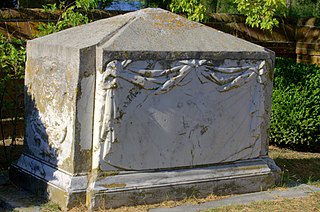
Custis Tombs, also known as Custis cemetery at Arlington, is a historic family burial ground located near Cheapside, Northampton County, Virginia. It consists of two tombs surrounded by a poured concrete platform raised a few inches above ground level. It includes the grave of John Custis (1630-1696), Major General and member of the Council for Virginia and progenitor of the Custis family in America. The other tomb is the box-like marble tomb of John Custis IV (1678-1749) with its pyramidal top and drapery carvings on the long sides. The tombs were associated with Arlington mansion and located west of the separately listed Arlington Archeological Site.

Longs Chapel, also known as Old Athens Church and Athens Colored School, is a historic Church of the United Brethren in Christ church and cemetery located at Zenda near Harrisonburg, Rockingham County, Virginia. It was built about 1871, and is a small, one-story, frame structure with a standard gable-fronted nave form with weatherboard siding, metal roofing, stone foundation piers, a small belfry, and an apse added about 1900. It measures approximately 20 feet by 30 feet. The cemetery includes multiple grave depressions, fieldstone tombstones, and a number of professionally carved marble monuments. The church also housed a one-room school for African-American children where Harrisonburg educator Lucy F. Simms first taught beginning in the 1870s. The school at Zenda closed in 1925 and the last services at Longs Chapel were held in the late 1920s. The building was subsequently used as a hay barn. The last burial was in 1935.

Kimberling Lutheran Cemetery is a historic Lutheran cemetery and national historic district located near Rural Retreat, Wythe County, Virginia. The cemetery includes approximately about 50 early Germanic sandstone monuments dating from 1800 to 1850. The associated Kimberling Lutheran Church was built in 1913, and is a large frame structure with two unequal-sized towers.

West Point Cemetery, also known as Potter's Field and Calvary Cemetery, is a historic cemetery and national historic district located at Norfolk, Virginia. It encompasses three contributing sites, one contributing structure, and one contributing object in an African American graveyard in downtown Norfolk. The cemetery was established in 1873, and includes a grouping of headstones marking the remains of 58 black soldiers and sailors who served in the American Civil War, and a monument honoring these veterans stands over their graves. Other notable elements include the Potter's Field, O’Rourke Mausoleum, and the West Point Cemetery entry sign.

Mount Moriah Baptist Church and Cemetery is a historic African-American Baptist church and cemetery located at Roanoke, Virginia. It was built about 1908, and is a small, one-story, rectangular frame church sheathed in weatherboard. It consists of a main sanctuary, a front vestibule, and a rear chancel bay. The frame building sits on a raised foundation of uncoursed fieldstones. The associated burial ground contains over 100 interments from the 1870s through the present.
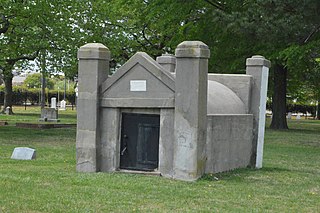
Elmwood Cemetery is a historic municipal cemetery located at Norfolk, Virginia. It was established in 1853, and is filled with monuments and mausoleums that embody the pathos and symbolism of the Christian view of death as a temporary sleep. A notable monument is the Recording Angel by William Couper (1853–1942) at the Couper Family plot. The Core Mausoleum (1910–1915) designed by Harold Van Buren Magonigle (1867–1935), with sculptures by Edward Field Sanford, Jr. (1886–1951), is another notable resource.































